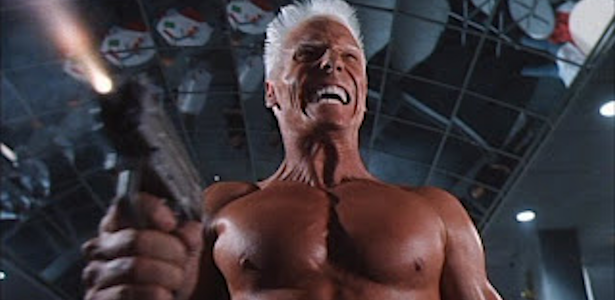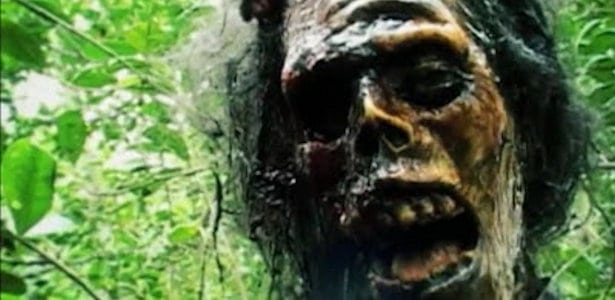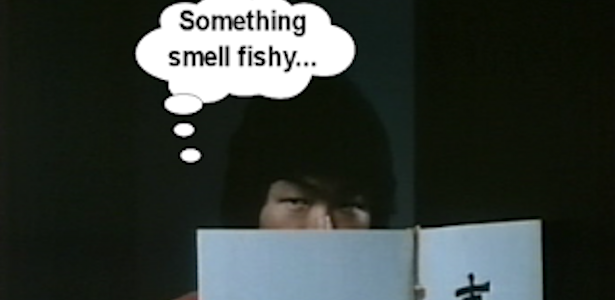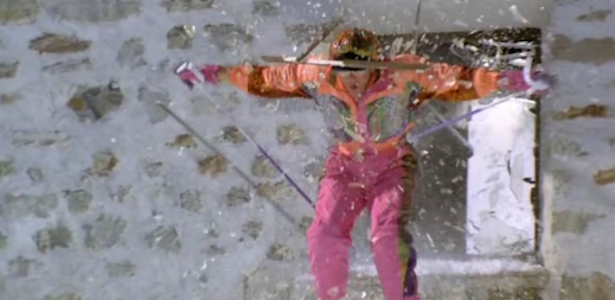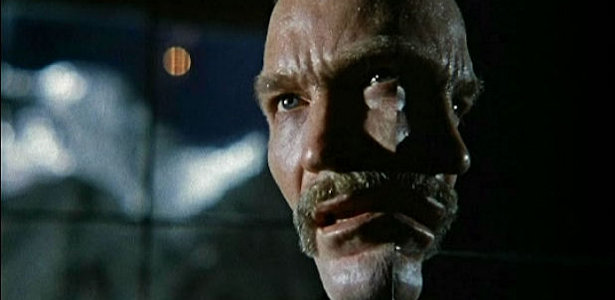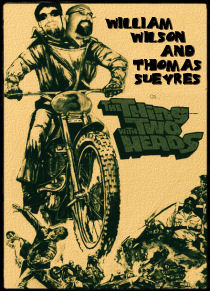As Tom mentioned in our H.P. Lovecraft coverage re-launch, Lovecraft purists have to maintain measured outlooks when it comes to adaptations. They should also temper their expectations when it comes to the actual filmmaking as Lovecraft doesn’t get the studio execs forking over tens of millions (probably the biggest budget given a U.S. Lovecraft adaptation was Dan O’Bannon’s THE RESURRECTED [1991] at $6 million) and it won’t change until Guillermo del Toro adapts AT THE MOUNTAINS OF MADNESS (spoiler alert: It’s never gonna happen, kids!).
For better or worse, H.P. Lovecraft remains in the realm of low budget filmmakers. Perhaps they are drawn to his creative scenarios and “out of the box” ideas. Or it is the fact that Lovecraft is a marketable name whose works are in public domain? Yeah, it is totally the latter. That doesn’t stop filmmakers from attempting to do their best with Lovecraft’s prose and it is how we end up with PICKMAN’S MUSE, the feature film debut from Robert Cappelletto that melds the two short stories “Pickman’s Model” and “The Haunter of the Dark.”
The story opens with painter Robert Pickman (Barret Walz) visiting his psychologist, Dr. Ambrose Dexter (Maurice McNicholas). It seems Pickman is suffering from an ultimate case of writer’s…er, painter’s block and all the pills in the world can’t help him return to his profitable world of lighthouses and seascapes. To make matters worse, the landlady to his one room apartment is pushing her niece upon him. “She’s pretty. She doesn’t have any friends either,” she says, obviously needing to brush up on her sale’s techniques. Pickman’s artistic dry spell comes to an abrupt halt when he is woken up one day by a powerful, glowing sunrise coming through his window. Staring off into the sky, Pickman becomes transfixed by a church in the horizon and soon begins obsessively drawing and painting this impressive architectural structure.
Pickman takes his latest piece to his agent, who is shocked by it. Not only is it a markedly dramatic shift in his style, but the church painting is a dead on replica of the work of Goodies Hines (Tom Lodewyck). Plagiarism is the least of Pickman’s worries though as his agent explains that Hines “killed and mutilated seven people” in an effort to fuel his creative passion. Even worse, Hines is locked up at the local loony bin and his doctor just happens to be…Dr. Dexter. (insert dramatic music) All of this piques Pickman’s curiosity more and he soon finds himself hearing voices and is drawn to the abandoned church. Crawling among the ruins, he discovers a strange box hidden in a crawlspace. Inside the box is a glowing purple orbs that, when looked upon, immediately zaps Pickman back to his apartment where he is painting pieces that seem to drive people insane upon sight. Meanwhile, Dr. Dexter, concerned for his Pickman’s wellbeing, starts investigating the object of Pickman’s obsession and soon unearths the church’s dark past.
We were able to follow the progress of PICKMAN’S MUSE over the years on the fantastic (and sadly now defunct) Unfilmable blog by our buddy Craig. Although early posters declared the film as “based on H.P. Lovecraft’s ‘Haunter of the Dark,’” it is actually more of melding of the two aforementioned short stories to create a Lovecraftian world rather than a straight adaptation. The painter elements are obviously from “Pickman’s Model” while the main plot and Dr. Dexter are from “The Haunter of the Dark.” I’m not sure why Cappelletto didn’t just stick with the latter since most of the film centers on the Church of Starry Wisdom and the Shining Trapezohedron (the object found inside the church). However, the melding of the two ideas works in the film’s favor as the idea of the artist’s struggle/obsession works well into the idea of the Old Ones granting wishes for their return.
One of the film’s biggest strengths is Cappelletto’s ability to deliver a sense of style and build mood on what I assume was a tight budget. The director was also his own cinematographer and he captures some really artistic shots. Little touches like a dripping water pipe and a dog incessantly barking help successfully build dread on the screen. Also, Cappelletto has found a killer location for the abandoned church. Dilapidated and cordoned off by a big chain link fence, it reminds me of John Carpenter’s moody main location in PRINCE OF DARKNESS (1987). I actually wished they had used this location more (a climactic scene in Pickman’s apartment would have been better set here). It also served as a great set up for the film’s spookiest scene when Dr. Dexter spots an octopus nailed to a makeshift cross.
Naturally, there is some bad stuff as well. The acting – as in most low budget films – comes in peaks and valleys. Lead Barret Walz is good in the main role of the tortured artist. Alternately looking like Matthew McConaughey and Barry Pepper, he adequately conveys the inner torment that Pickman is going through. On the other end of the spectrum is pretty much the rest of the cast as everyone is pretty bad. While I hate to single out a specific performer, Maurice McNicholas as Dr. Dexter is pretty rough. He certainly looks the part of a learned psychologist, but, man, he is bad. The is one scene where he is questioning some jump roping girls outside of the church and they act better than him. This hurts the film because viewers will most likely become attached to this character the most as he begins investigating.
That said, I’d still recommend PICKMAN’S MUSE to the interested Lovecraft fan. Notice I didn’t say horror fan. If you were raised on the likes of RE-ANIMATOR (1985) or, hell, THE UNNAMABLE flicks, you will no doubt be disappointed by a film like this that keeps the gore and monsters in the shadows. All in all, I enjoyed PICKMAN’S MUSE despite a few low budget shortcomings. I give the film an H (honorable) for effort and P (pass) for its craft.
For better or worse, H.P. Lovecraft remains in the realm of low budget filmmakers. Perhaps they are drawn to his creative scenarios and “out of the box” ideas. Or it is the fact that Lovecraft is a marketable name whose works are in public domain? Yeah, it is totally the latter. That doesn’t stop filmmakers from attempting to do their best with Lovecraft’s prose and it is how we end up with PICKMAN’S MUSE, the feature film debut from Robert Cappelletto that melds the two short stories “Pickman’s Model” and “The Haunter of the Dark.”
The story opens with painter Robert Pickman (Barret Walz) visiting his psychologist, Dr. Ambrose Dexter (Maurice McNicholas). It seems Pickman is suffering from an ultimate case of writer’s…er, painter’s block and all the pills in the world can’t help him return to his profitable world of lighthouses and seascapes. To make matters worse, the landlady to his one room apartment is pushing her niece upon him. “She’s pretty. She doesn’t have any friends either,” she says, obviously needing to brush up on her sale’s techniques. Pickman’s artistic dry spell comes to an abrupt halt when he is woken up one day by a powerful, glowing sunrise coming through his window. Staring off into the sky, Pickman becomes transfixed by a church in the horizon and soon begins obsessively drawing and painting this impressive architectural structure.
Pickman takes his latest piece to his agent, who is shocked by it. Not only is it a markedly dramatic shift in his style, but the church painting is a dead on replica of the work of Goodies Hines (Tom Lodewyck). Plagiarism is the least of Pickman’s worries though as his agent explains that Hines “killed and mutilated seven people” in an effort to fuel his creative passion. Even worse, Hines is locked up at the local loony bin and his doctor just happens to be…Dr. Dexter. (insert dramatic music) All of this piques Pickman’s curiosity more and he soon finds himself hearing voices and is drawn to the abandoned church. Crawling among the ruins, he discovers a strange box hidden in a crawlspace. Inside the box is a glowing purple orbs that, when looked upon, immediately zaps Pickman back to his apartment where he is painting pieces that seem to drive people insane upon sight. Meanwhile, Dr. Dexter, concerned for his Pickman’s wellbeing, starts investigating the object of Pickman’s obsession and soon unearths the church’s dark past.
One of the film’s biggest strengths is Cappelletto’s ability to deliver a sense of style and build mood on what I assume was a tight budget. The director was also his own cinematographer and he captures some really artistic shots. Little touches like a dripping water pipe and a dog incessantly barking help successfully build dread on the screen. Also, Cappelletto has found a killer location for the abandoned church. Dilapidated and cordoned off by a big chain link fence, it reminds me of John Carpenter’s moody main location in PRINCE OF DARKNESS (1987). I actually wished they had used this location more (a climactic scene in Pickman’s apartment would have been better set here). It also served as a great set up for the film’s spookiest scene when Dr. Dexter spots an octopus nailed to a makeshift cross.
Naturally, there is some bad stuff as well. The acting – as in most low budget films – comes in peaks and valleys. Lead Barret Walz is good in the main role of the tortured artist. Alternately looking like Matthew McConaughey and Barry Pepper, he adequately conveys the inner torment that Pickman is going through. On the other end of the spectrum is pretty much the rest of the cast as everyone is pretty bad. While I hate to single out a specific performer, Maurice McNicholas as Dr. Dexter is pretty rough. He certainly looks the part of a learned psychologist, but, man, he is bad. The is one scene where he is questioning some jump roping girls outside of the church and they act better than him. This hurts the film because viewers will most likely become attached to this character the most as he begins investigating.
That said, I’d still recommend PICKMAN’S MUSE to the interested Lovecraft fan. Notice I didn’t say horror fan. If you were raised on the likes of RE-ANIMATOR (1985) or, hell, THE UNNAMABLE flicks, you will no doubt be disappointed by a film like this that keeps the gore and monsters in the shadows. All in all, I enjoyed PICKMAN’S MUSE despite a few low budget shortcomings. I give the film an H (honorable) for effort and P (pass) for its craft.




